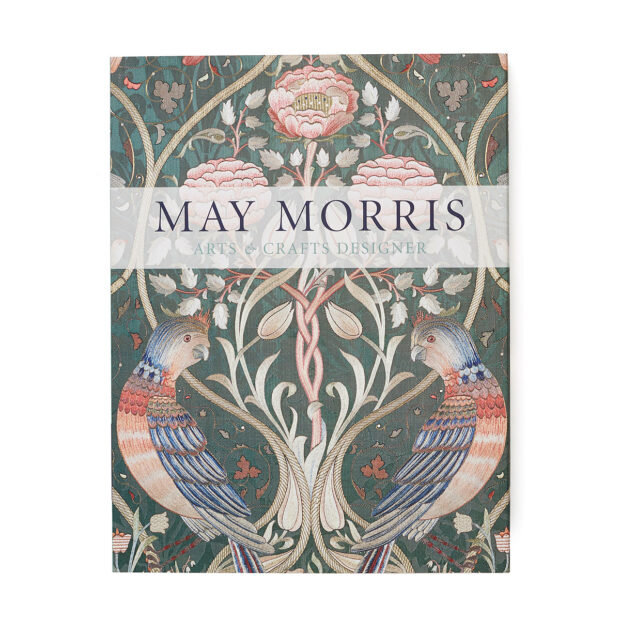May Morris Art & Life Exhibition
On the way north to Cambridge, we stopped at the William Morris Gallery in Walthamstow to see the May Morris: Art and Life exhibition. The museum is open from Wednesday through Sunday so going over while we were in Chiswick didn't work out. Fortunately, it was a very short detour from Tonbridge on the way to Cambridge!I hadn't been to the WM Gallery since Nicola Jarvis had her fabulous exhibition The Art of Embroidery in 2013.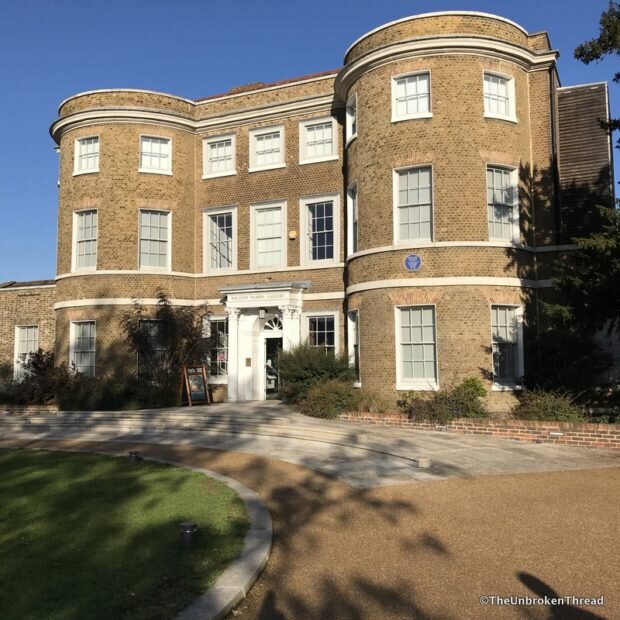 The Museum is a small, intimate building in a leafy neighbourhood and, as you can see, it was a lovely, sunny day!The entrance to the exhibition is printed on a reproduction piece of Honeysuckle wallpaper, one of Morris and Co. best selling designs. There is a debate as to who designed it - May or her father, William. However, evidence points to May having been the designer.
The Museum is a small, intimate building in a leafy neighbourhood and, as you can see, it was a lovely, sunny day!The entrance to the exhibition is printed on a reproduction piece of Honeysuckle wallpaper, one of Morris and Co. best selling designs. There is a debate as to who designed it - May or her father, William. However, evidence points to May having been the designer.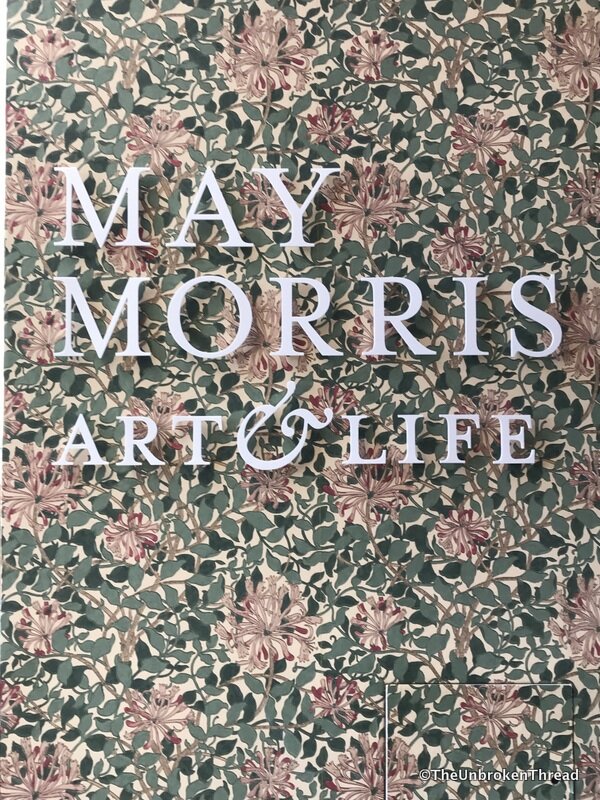 In the posts to come about the exhibition I'll be writing more about what I saw in the embroidery work and what inspires me. When I go to an exhibition I am most interested in learning how accomplished designers and embroiderers work. What is their inspiration? What stitches do they use? What thread? What are their fabric choices? There's so much to learn by observation!I'll include some historical information, but to really learn about May Morris and her life and work, I recommend one of the two books at the end of this article.
In the posts to come about the exhibition I'll be writing more about what I saw in the embroidery work and what inspires me. When I go to an exhibition I am most interested in learning how accomplished designers and embroiderers work. What is their inspiration? What stitches do they use? What thread? What are their fabric choices? There's so much to learn by observation!I'll include some historical information, but to really learn about May Morris and her life and work, I recommend one of the two books at the end of this article. The first two pieces inside the door are entitled "Spring and Summer" panel and "Autumn and Winter" panel. I didn't get farther than these two panels for quite a while. Fortunately, my husband is interested in embroidery and infinitely patient!As I examined these two panels, I noticed right away that they were stitched on silk damask fabric. I learned from the exhibition catalogue that the fabric is called "Oak". I've only worked one piece on a patterned fabric - a white cotton damask - and I loved it. Why haven't I done that more often?I also noticed that the lattice that covers the top 1/5 of the piece is all laid threads couched down with a single thread. Very simple, but very effective.
The first two pieces inside the door are entitled "Spring and Summer" panel and "Autumn and Winter" panel. I didn't get farther than these two panels for quite a while. Fortunately, my husband is interested in embroidery and infinitely patient!As I examined these two panels, I noticed right away that they were stitched on silk damask fabric. I learned from the exhibition catalogue that the fabric is called "Oak". I've only worked one piece on a patterned fabric - a white cotton damask - and I loved it. Why haven't I done that more often?I also noticed that the lattice that covers the top 1/5 of the piece is all laid threads couched down with a single thread. Very simple, but very effective. The leaf, above, comes from the bottom of the panel and appears to be worked again in laid threads couched down with a single thread in a brick pattern. This is the same stitch used in the Bayeux Tapestry. Simple and pretty! Look closely and you'll notice that the stems of the leaf are also couched down threads - very similar to what we do in metal thread work when couching down passing thread.
The leaf, above, comes from the bottom of the panel and appears to be worked again in laid threads couched down with a single thread in a brick pattern. This is the same stitch used in the Bayeux Tapestry. Simple and pretty! Look closely and you'll notice that the stems of the leaf are also couched down threads - very similar to what we do in metal thread work when couching down passing thread.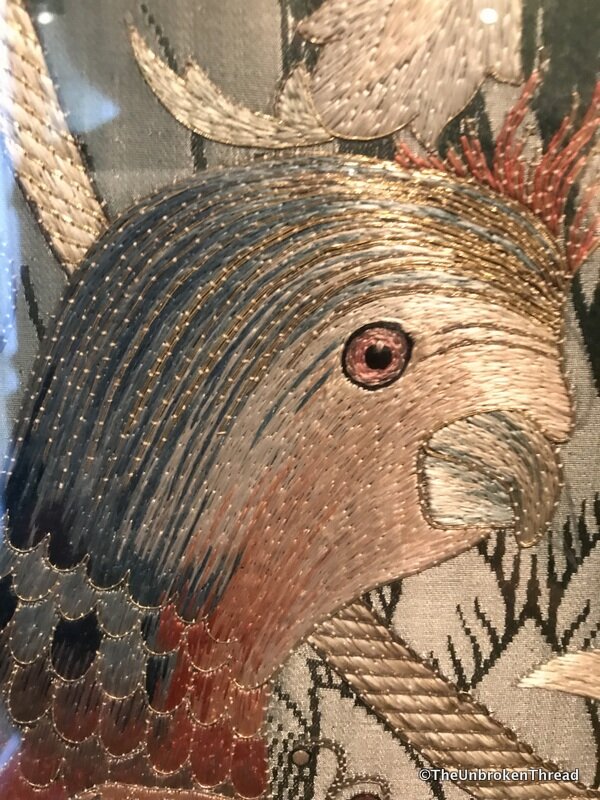 Each panel has two large parakeets which are embroidered in silk thread. The stitch appears to be a tapestry stitch - or long and short shading. It's as if she is drawing with coloured pencils that are made of thread! This is shading of the highest quality and skill. There are also some gold threads which have been couched down with silk (I assume) to highlight parts of the design. Again, not complicated but brilliant!
Each panel has two large parakeets which are embroidered in silk thread. The stitch appears to be a tapestry stitch - or long and short shading. It's as if she is drawing with coloured pencils that are made of thread! This is shading of the highest quality and skill. There are also some gold threads which have been couched down with silk (I assume) to highlight parts of the design. Again, not complicated but brilliant!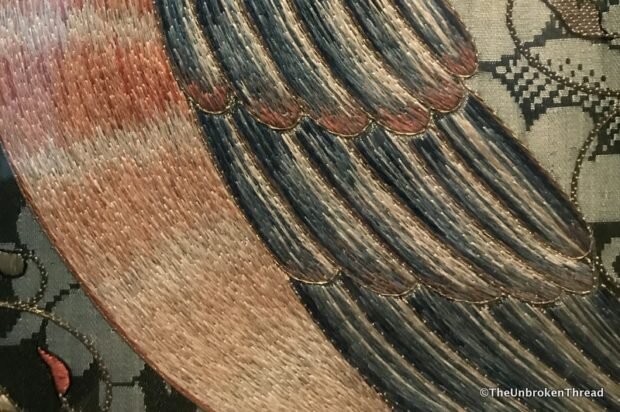 The wings of the parakeets are done in tapestry stitch (or shading) and each feather is outlined with metal thread that has been couched down. Note the delicate shading on the breast of the parakeet.
The wings of the parakeets are done in tapestry stitch (or shading) and each feather is outlined with metal thread that has been couched down. Note the delicate shading on the breast of the parakeet. The tail feathers really caught my imagination! The center feather uses only 4 colours - a grey/ivory, two shades of blue and deep red. With the exquisite stitching, however, it seems as though there are many more colours. Looking carefully, you can see why we often call "long and short" shading "longer and shorter" shading! It's that wide variation in stitch length that is the artistry.
The tail feathers really caught my imagination! The center feather uses only 4 colours - a grey/ivory, two shades of blue and deep red. With the exquisite stitching, however, it seems as though there are many more colours. Looking carefully, you can see why we often call "long and short" shading "longer and shorter" shading! It's that wide variation in stitch length that is the artistry.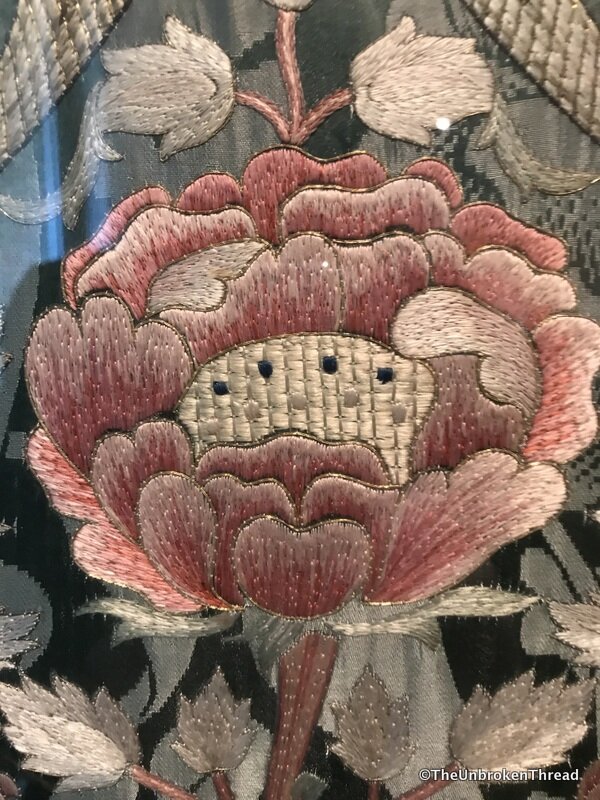 According to the text of the book, "May Morris, Arts and Crafts Designer", the large flowers in the piece are stylised roses. I thought they were peonies! Either way, the direction of the tapestry stitching is a lesson in always stitching in the direction of the growth when embroidering something from nature. Note how the stitches follow the growth direction of the petals.
According to the text of the book, "May Morris, Arts and Crafts Designer", the large flowers in the piece are stylised roses. I thought they were peonies! Either way, the direction of the tapestry stitching is a lesson in always stitching in the direction of the growth when embroidering something from nature. Note how the stitches follow the growth direction of the petals.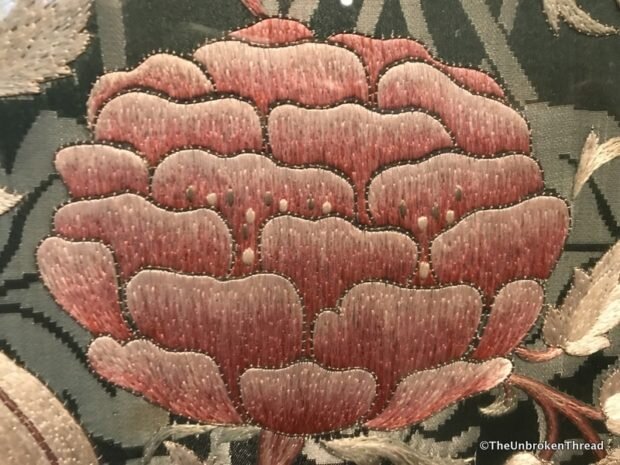 In the photo above, you can see how the different perspective is supported by the direction of the stitches. In this flower all the stitches are vertical, reflecting what we would see when looking at a partially opened flower.
In the photo above, you can see how the different perspective is supported by the direction of the stitches. In this flower all the stitches are vertical, reflecting what we would see when looking at a partially opened flower. This pink bird is, again, stitched simply using tapestry shading and a limited colour palette of pinks and ivory but looks so realistic!
This pink bird is, again, stitched simply using tapestry shading and a limited colour palette of pinks and ivory but looks so realistic!  The stem on the right is particularly interesting; threads have been laid following the curve of the stem and then the couching stitches are done at a slight angle. The breast of the blue bird is just perfect with the addition of a flew dark blue stitches. Without them, it would look flat and lifeless.
The stem on the right is particularly interesting; threads have been laid following the curve of the stem and then the couching stitches are done at a slight angle. The breast of the blue bird is just perfect with the addition of a flew dark blue stitches. Without them, it would look flat and lifeless.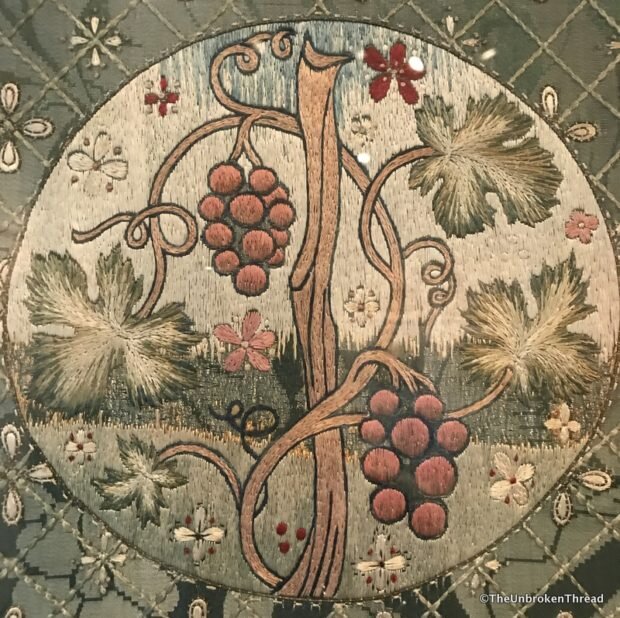 This small roundel is on the left of the Autumn and Winter panel and depicts the grape harvest. Note how few stitches she's used to fill the space. I see only tapestry stitches and satin stitches. The small dots around the little white flowers might be French knots...As she wrote in her book, Decorative Needlework, excellence was not about mastering many exotic and difficult stitches, but making expressive use of a few ordinary ones such as simple running and darning stitches. This first piece in the exhibition proves that beyond a shadow of a doubt!If you're interested in her life, here is a link to an excellent article in The Guardian.Below are the two books that are available at the William Morris exhibition and online from the usual booksellers. If you click on each book cover, you will be taken to a web site where there is further information about the book; the Victoria and Albert Museum for May Morris Arts & Crafts Designer or Ornamental Embroidery for May Morris: Art and Life. I can highly recommend both!
This small roundel is on the left of the Autumn and Winter panel and depicts the grape harvest. Note how few stitches she's used to fill the space. I see only tapestry stitches and satin stitches. The small dots around the little white flowers might be French knots...As she wrote in her book, Decorative Needlework, excellence was not about mastering many exotic and difficult stitches, but making expressive use of a few ordinary ones such as simple running and darning stitches. This first piece in the exhibition proves that beyond a shadow of a doubt!If you're interested in her life, here is a link to an excellent article in The Guardian.Below are the two books that are available at the William Morris exhibition and online from the usual booksellers. If you click on each book cover, you will be taken to a web site where there is further information about the book; the Victoria and Albert Museum for May Morris Arts & Crafts Designer or Ornamental Embroidery for May Morris: Art and Life. I can highly recommend both!